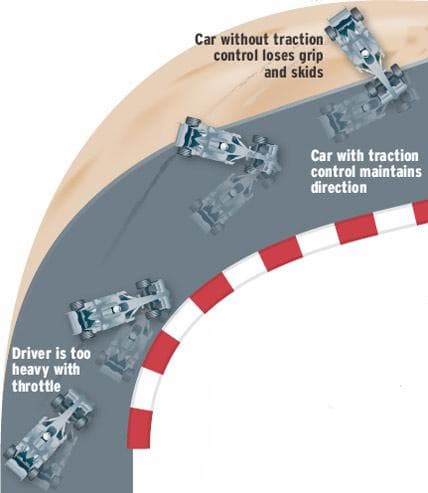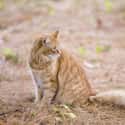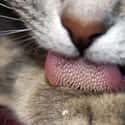-
(#1) Dogs Can Retract Their Eyeballs Into Their Sockets
If you’ve ever tried to give your dog eye drops, you may have noticed that the eyeball seems to disappear. Dogs don’t have magical eyeballs, but they do have a wondrous set of muscles called retractor bulbi.
These muscles allow dogs to retract their eyeballs into their sockets, far away from that eye dropper (or anything else they don’t want near their eyes).
-
(#2) Woodpeckers Have A Bone In Their Insanely Long Tongues
The anatomy of a woodpecker’s tongue is so mind-boggling it might take a few head bumps off a tree to make sense of it. These freakishly long tongues extend from the throat to the jaw, past the sinus cavities, around the brain, and down through the nostril. Woodpeckers’ tongues are solid at the beginning, split for some of the long journey, and reunite at the tip.
As if that wasn’t crazy enough, woodpecker's have a bone in their tongues; they can peck through a lot more than trees.
-
(#3) Argonaut Octopuses Have Detatchable Penises
In usual mating situations, the male spreads his seed and the female pretty much just lets him. Then there are Argonaut octopuses, truly unique in the animal kingdom. A male Argonaut keeps his sperm in a detachable tentacle – yes, that’s what it’s technically called – and throws said tentacle in the general direction of a female, so she can fertilize herself. After detaching his, errr, special tentacle, the male dies.
The female shows her appreciation by collecting the spermy tentacles from different ‘donors’ and fertilizing herself as often as she wants. How’s that for the most impersonal (and horrifying) mating ritual imaginable?
-
(#4) Almost 10 Percent Of Cat Bones Are In Their Tails
Cats use their tails to share their mood and to land on their feet when they jump (or fall) from that bookcase you keep telling them not to climb. Their tails aren’t just handy tools to keep their humans from hyperventilating. Cats’ tails are complex anatomical structures that keep them balanced – so complex, in fact, that they house ten percent of a feline’s bones.
With about 20 vertebrae in their tails alone (give or take depending on their breeds), it’s no wonder cats express their feelings through their most complicated appendages!
-
(#5) Female Hyenas Have Pseudo-Penises
In a bizarre trick of evolution (or lack thereof), female hyenas have super masculine genitals. What looks like a penis (often referred to as a "pseudo-penis") is actually an extremely large clitoris that hangs down approximately seven inches.
As the dominant hyena sex, females have no problem attacking would-be-suitors. If a male wants to be intimate, he has to show his submission. If the female doesn't attack him right away, there's still have the obstacle of basically trying to squeeze a penis into a penis.
If mating is successful, female hyenas have to go through the pain of birth -- the only thing more painful and awkward than mating. While trying to squeeze a baby hyena out of a one inch tube, everyone involved is in danger. First time hyena mothers often bleed to death. If the mother survives, she still has to face the death of most of her offspring who suffocate on the long, narrow road.
When put into context, it's not hard to see why female hyenas are the alpha gender!
-
(#6) Kangaroos Have Three Vaginas
Proving that good things really do come in threes, female kangaroos, koala bears, Tasmanian devils, and wombats all have three vaginas. So what makes the kangaroo so special? Well, along with their three vaginas, kangaroos also have two uteruses (or uteri, depending on your word preference).
The three vaginas are arranged like a trident, the uteruses sitting between the trident prongs. The left and right vaginal canals are used as sperm tunnels and the middle vagina is the birthing canal. Baby kangaroos (joeys) are about the size of a bean when they're born, because there's a lot going on in there, and little room to spare.
Kangaroos can get pregnant in both uteruses at the same time, give birth to a joey, store said joey in their pouch, and then keep the cycle going. Basically, kangaroos are always pregnant, pretty much guaranteeing that their species won't be endangered any time soon. -
(#7) Chickens Sometimes Change Genders
Forget about the age old question about the chicken and the egg. This is a lesson about the chicken and the rooster -- or rather, the chicken who becomes the rooster.
During the embryonic stage, chickens have two gonads. The left gonad turns into an ovary or testicle and the right one just sort of sits there. When the sex gene produces a female, the hen will be born with an ovary and all the hormones that go with it.
If something goes wrong with the left ovary, a hen's body goes into a bit of a panic. That's when the right gonad that was previously useless comes into play. In rare but real circumstances, the right gonad can start acting as a testes and release male hormones into the hen. At this point, the chicken will lose the ability to lay eggs and develop unladylike characteristics. The gender-confused chicken doesn't become the total rooster package, but she will look, sound, and act like a rooster.
Cock-a-doodle-doo, indeed! -
(#8) Hamsters' Cheek Pouches Extend From Mouth To Hip
Everyone knows that hamsters, chipmunks, squirrels, and the majority of furry critters store food in their cheeks. Most people don't realize how much. In first place for storing as much food as possible, hamster's cheek pouches extend all the way from their mouths to their hips.
Relative to a hamster's size, that's a whole lot of food, making them leaders in the anatomical storage space sweepstakes.
-
(#9) Horned Lizards Can Squirt Toxic Blood From Their Eyes
When it comes to defense mechanisms, horned lizards win all the points. They defend themselves in three ways, depending on what wants to eat them at any given moment, and the final line of defense is truly insane.
The horned lizard's first defense mechanism is its camouflage. It's hard to notice these cold-blooded critters in their natural habitat, and if they are spotted, their spiky appearance makes them seem formidable. If the 'you can't see me' approach doesn't work, horned lizards freak out predators by puffing their bodies up to twice their normal size, flipping onto their backs, and acting totally loco.
If the first two off-putting strategies don't work, it's time to call in the big guns and use the craziest defense tactic in existence. Typically saved for dogs, cats, and coyotes, horned lizards can scare off their enemies by squirting toxic blood from their eyes.
Yes, you read that right. Horned lizards can control the force of blood pressure within their heads and let it build up around their eyes. When the pressure is strong enough, they shoot the blood up to five feet, and can even control the direction in which it goes. They can repeat this several times, but once is usually enough to do the trick. As if a lizard squirting blood from its frickin' eyeballs weren't scary enough, the blood tastes disgusting to cats and dogs.
-
(#10) Frogs Have Short, Backwards Tongues
Know that image you have of a frog unrolling its super long tongue like a red carpet to catch a fly? Sadly, frog tongues don’t work that way. (Childhood ruined, right?) Frogs actually have short, wide tongues similar to what we have. The only difference is that a frog’s tongue is attached backwards at the front of the mouth.
Rather than chasing down prey, frogs wait for flies or other nummy treats (by frog standards) to approach. Then the frog darts out its sticky tongue, gives its prey a smack down, and swallows it whole before the victim even sees it coming.
-
(#11) Males And Females Make Pigeon Milk
In most species, women are responsible for bringing the milk to the party. That's not the case for pigeons, though. Both male and female pigeons create "pigeon milk," a thick liquid similar to the milk produced by mammals. This substance grows between the esophagus and stomach, and is only created around hatching time.
When a pigeon hatches, both parents regurgitate pigeon milk and force it into the baby pigeon's mouth. The process looks like the parents are trying to eat their young, but really they're just feeding their baby in a gross way.
-
(#12) Dogs Have Three Eyelids
Dogs (along with some cats, fish, and lizards) have three eyelids. The first two eyelids are on the top and bottom. The third eyelid extends sideways from the corner of the eye. It’s not usually visible, though it can be noticed during deep stages of relaxation.
So if your sleepy pup seems to be giving you the evil eye, rest assured that your dog is assuredly resting.
-
(#13) Hamsters' Front Teeth Never Stop Growing
Hamsters like to gnaw on things, which works out since their front teeth never stop growing. While it's good to know they never have to worry about caps or dentures, a hamster's constantly growing teeth can lead to serious mouth injuries if they're not naturally shortened.
Plus, if they didn't keep their mouths going, they would look like fuzzy hamster-walrus hybrids. That doesn't sound cute at all, so here's hoping that hamster gnawing never goes out of style.
-
(#14) The Number Of Rings On A Cow's Horns Show Its Age
If anyone has ever wondered if cows are similar to trees, the answer is yes. The rings on a cow's horns show its age just like the rings in a tree trunk. Of course, cows are more active than trees, so their rings eventually start to fade.
But if you ever want to know a cow's approximate age, take a close look at its horns -- just not too close.
-
(#15) Horses Don't Have Gallbladders
Breakfast may be the most important meal of the day for people, but for horses, everything is the most important meal of the day. Unlike humans, horses need to keep eating day and night without choosing special times to splurge. They graze and graze, keeping a steady stream of healthy food in their systems, and use their livers to burn the small amounts of fat they ingest in the process.
Since horses don't need buckets of bile to break down the little fat they find within forage, their bodies have no use for gallbladders.
-
(#16) Dogs' Shoulders Aren't Attached To Any Other Bones
Domesticated dogs are more likely to chase rubber balls than hunt prey, but their bodies are built the same way as their wolfy ancestors. Dogs gain their incredible flexibility from the way their shoulder blades connect to their bodies – or more accurately, because of the ways they don’t.
Unlike most species, dogs’s shoulder blades are free ranging, and only connected to the rest of their skeletal systems by muscle. That flexibility boost helps dogs run at a gallop, giving them at least half the skills they need to play fetch or ultimate Frisbee. (Whether or not they give the toy back is all on you!) -
(#17) Lizards Can Willingly Detach Their Tails
In a trippy form of body modification, lizards can detach their tails at will. If they feel like they're in danger, lizards drop their tails and make a run for it. Predators let them get away because they're distracted by the tail that keep wiggling long after the rest of the spinal column has fled. Lizards's tails eventually grow back, but not usually in the same color.
So if you see an orange lizard with a green tail (or vice versa), your eyes aren't playing tricks on you -- the self-mutilating lizard is.
-
(#18) Goldfish Don't Have Stomachs
Have you ever wondered how goldfish survive off those tiny flecks of food in their tanks? Scientifically speaking, the small amount of food they ingest is the reason they can survive. Goldfish don't have stomachs, so they don't have anywhere to store larger portions of food.
Their meals travel from their mouths to their throats to their intestines. No need to explain what happens from that point.
-
(#19) Pigs Don't Have Sweat Glands
Pigs aren't particularly dirty animals. They're just hot and mud is cold. Since pigs don't have productive sweat glands, they gravitate towards the coolest spots they can find. Rolling in the mud may not seem like a cool way to spend an afternoon by human standards, but for pigs, that's as cool as things get. -
(#20) Cat Tongues Are Covered in Barbs
Imagine barbed wire. Now imagine a fleshy version of that on your cat’s tongue (along with the sandpaper sensation of being licked by said cat). Those barbs are called papillae, and they serve as itty bitty kitty hooks. When cats groom themselves, the papillae hook onto loose fur and dirt, leaving their coats extra clean.
Since these barbs face backwards, cats usually swallow anything their tongues scoop up, leading to not-so-clean looking hairballs.
New Random Displays Display All By Ranking
About This Tool
Fish, reptiles, birds, amphibians, mammals, and other vertebrates are the main objects of animal anatomy. They are supported by the skeletal system inside the body just like humans. The structure of vertebrates is complex and precise and is very similar to human features. Anatomy is the most direct way to understand animal structure.
When we have a good understanding of the anatomical structure of animals, we can get a good understanding of the differences in different animals without being deceived by appearance. There is an interesting collection. The random tool displays 20 weird anatomical features of common animals in daily life.
Our data comes from Ranker, If you want to participate in the ranking of items displayed on this page, please click here.






























